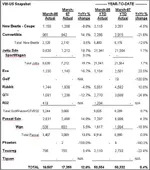chonkoa
Aerodynamic Artisan
Audi March '08 Sales:
Total March sales = 7989 units, a 0.4% decrease against 2007 numbers(8020)
A3= 408 units
A4/S4/RS4= 3495 units
A4/S4 Cab = 566 units
A5/S5 units = 464 units
A6/S6 units = 898 units
A8/S8 units = 249 units
TT = 473 units
R8 = 44 units
Q7 = 1309 units
BMW March '08 Sales
Total BMW Brand for March is 23,115 a decrease of 8.7% against 2007 numbers (25,325)
Total BMW group sales is 27,404 a decrease of 5.4% against 2007 numbers (28,980)
Breakdown as follows:
1 Series = 1496
3 Series = 11,226 units
5 Series = 3677 units
6 Series = 593 units
7 Series = 1,467 units
Z4 Roadster = 772 units
X3 SAV = 1732 units
X5 SAV = 3884 units
Mini Brand = 4,289 units
BMW Group Reports March Sales
Mercedes-Benz March '08 Sales
Total Mercedes Benz sold=20808, a decrease of 3.7% over 2007(21612 units).
C Class = 6713 units
E Class = 3039 units
S Class = 1622 units
CL Class = 297 units
SL Class = 379 unis
CLK Class= 1218 units
SLK Class= 561 units
CLS Class= 935 units
R Class = 874 unts
M Class = 3189 units
GL Class = 1908 units
G Class = 73 units.
19708
Porsche March '08 Sales
Total March sales of 2624 units, a drop of 20% against 2007 numbers(3278 units)
Boxter/Caymen = 572 units
All 911 = 825 units
Cayenne = 1227 unts
VW March '08 Sales

VW Newsroom: VOLKSWAGEN REPORTS MARCH 2008 SALES
Total March sales = 7989 units, a 0.4% decrease against 2007 numbers(8020)
A3= 408 units
A4/S4/RS4= 3495 units
A4/S4 Cab = 566 units
A5/S5 units = 464 units
A6/S6 units = 898 units
A8/S8 units = 249 units
TT = 473 units
R8 = 44 units
Q7 = 1309 units
BMW March '08 Sales
Total BMW Brand for March is 23,115 a decrease of 8.7% against 2007 numbers (25,325)
Total BMW group sales is 27,404 a decrease of 5.4% against 2007 numbers (28,980)
Breakdown as follows:
1 Series = 1496
3 Series = 11,226 units
5 Series = 3677 units
6 Series = 593 units
7 Series = 1,467 units
Z4 Roadster = 772 units
X3 SAV = 1732 units
X5 SAV = 3884 units
Mini Brand = 4,289 units
BMW Group Reports March Sales
Mercedes-Benz March '08 Sales
Total Mercedes Benz sold=20808, a decrease of 3.7% over 2007(21612 units).
C Class = 6713 units
E Class = 3039 units
S Class = 1622 units
CL Class = 297 units
SL Class = 379 unis
CLK Class= 1218 units
SLK Class= 561 units
CLS Class= 935 units
R Class = 874 unts
M Class = 3189 units
GL Class = 1908 units
G Class = 73 units.
19708
Porsche March '08 Sales
Total March sales of 2624 units, a drop of 20% against 2007 numbers(3278 units)
Boxter/Caymen = 572 units
All 911 = 825 units
Cayenne = 1227 unts
VW March '08 Sales

VW Newsroom: VOLKSWAGEN REPORTS MARCH 2008 SALES

